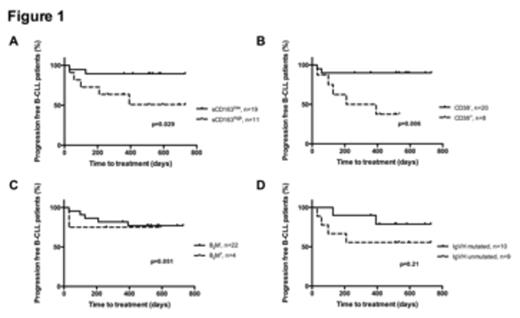Abstract
Markers indicative of prognosis play a consequential role in the clinical management of patients suffering from chronic B-cell lymphocytic leukemia (B-CLL). Soluble CD163 (sCD163) has been shown to be a useful biomarker in a wide variety of disease entities (Moller, 2012), however its presence in B-CLL has not been addressed.
Using an enzyme-linked immunosorbent assay the concentration of sCD163 was measured in peripheral blood of 30 B-CLL patients at diagnosis. The results were related to the course of disease for up to two years post diagnosis.
The median level of sCD163 in the plasma was not significantly higher in the B-CLL patients (2.085 mg/L, range 0.77- 9.01 mg/L) than in an age-matched control group (1.800 mg/L, range 0.97-2.45 mg/L) (n=10) (p=0.157). As CD163 is a monocyte/macrophage specific membrane protein, the relationship between the percentage of monocytes and the level of sCD163 was relevant. The level of sCD163 did not correlate with the percentage of monocytes in peripheral blood of the patients, but as previously described, there was an inverse correlation between measured sCD163 and the CD163 surface expression as measured by mean fluorescence intensity on the monocytes (r=0.088, p= 0.658 and r= -0.476, p=0.01, respectively) (Davis et al. 2005). Elevated levels of sCD163 have been linked to bacterial infection however in neither the B-CLL cohort nor the healthy control group, a correlation was found between the levels of sCD163 and CRP concentrations (r=0.24 and p=0.23 in B-CLL, and r=0.10 and p=0.81 in healthy controls) (Knudsen et al., 2007).
To test the prognostic impact of sCD163 the B-CLL patients were divided into two subsets using the highest level of sCD163 measured in the age-matched healthy control group as a cut-off. Hence, 11 of 30 B-CLL patients were assigned to an sCD163high group. In total, 7/30 (23%) patients experienced disease progression defined as need for cytoreductive treatment within the two years follow-up period. In more detail, 5/11 sCD163high patients (45%) and 2/19 patients (11%) in the sCD163low group received therapy (p=0.068). When analyzing the relevance of sCD163 in terms of predicting disease progression, there was a significant difference between patients in the two groups, indicating that patients with high concentrations of sCD163 in the plasma progressed more rapidly (p=0.029) (Figure 1A). In this cohort, CD38 expression was also of prognostic value for progressive disease (p=0.006) (Figure 1B), while b2M was of borderline significance (p=0.051) (Figure 1C). The role of mutational status as predictor of short time to treatment was not significant (p=0.21) (Figure 1D).
When performing the log-rank univariate analyses on the dataset, there was an obvious increased hazard of receiving treatment for patients in the sCD163high group compared to the sCD163low patients (Table I). As expected, CD38 expression, b2M, and IgVH mutational status were albeit to varying degrees covariates in the time to treatment analyses (Table I).
The data strongly indicate that sCD163 is a prognostic marker in B-CLL. The study is limited by the cohort size, however, indubitably, the results lay the ground for a larger study.
No relevant conflicts of interest to declare.
Author notes
Asterisk with author names denotes non-ASH members.



This feature is available to Subscribers Only
Sign In or Create an Account Close Modal